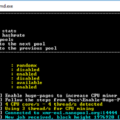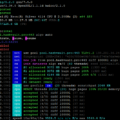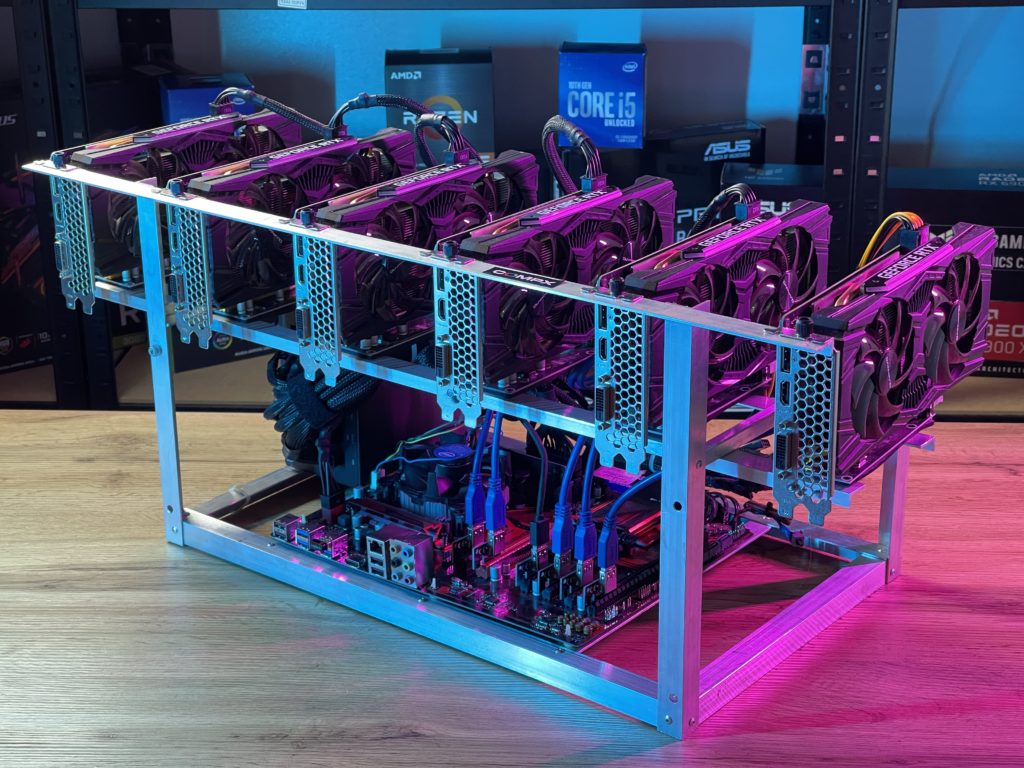
XMRig — High-performance cross-platform miner RandomX, CryptoNight and Argon2 CPU / GPU open source, with official support for Windows.
November 30, Monero (XMR) will work hard on block 1978433 to switch to a new algorithm. The upcoming fork will change the current CryptoNight R mining algorithm to the new Random X PoW algorithm, essentially transferring the coin mining to the CPU.
There are already several miners mining coins using the RandomX algorithm, one of which is XMRig v5.1.0, which you can download from the links below.
Notes
-
- Stay tuned about updates, follow me on twitter
- For NVIDIA CUDA mining support, use version with
cuda10_2suffix or any regular version with .
SHA256SUMS
bc3b0f4b3442b5159b57510d44123e96618caef637bc2202633cafa33d75ae02 *xmrig-6.3.3-bionic-x64.tar.gz
0bfb7ba998e5f70682cb3ee5332269a06b86f7884e98588014aec179f5b4f988 *xmrig-6.3.3-focal-x64.tar.gz
cfda6309ed0ce7ad0529500a78eac2112a47f79796a8d0ed4fee72211bcb168f *xmrig-6.3.3-freebsd-static-x64.tar.gz
ad1133cdcb486bab2368347b3ab35e83e5cd492c4bc6bfcb11a4b4c99d2c8014 *xmrig-6.3.3-linux-static-x64.tar.gz
8572c53b8085f5f269aa1070db460c5c5d6f79cfd8a211f74a54aa0841e4543f *xmrig-6.3.3-linux-x64.tar.gz
e9882f125c5b8c3740e82e916b0c4363572923b8e6eff1e89c52f153f6d70559 *xmrig-6.3.3-macos-x64.tar.gz
f13410f88d35cfe09c76efd75d55e9445c718f069e97858a261450af212ba641 *xmrig-6.3.3-gcc-win64.zip
0c227d4876456601ab966a386ab360cfbc957b7ff4ccc4d7944f25d49975c6bf *xmrig-6.3.3-msvc-cuda10_2-win64.zip
98f370f87b75e9d2718837c91746a0e6e04d292f4a348bc3fc457c5abdbc94e5 *xmrig-6.3.3-msvc-win64.zip
SHA256SUMS.sig
GPG public key: +
-----BEGIN PGP SIGNATURE-----
iQEzBAABCgAdFiEEmsTOqOZuNaXHzdwbRGpTY4vpRAkFAl9JGuQACgkQRGpTY4vp
RAnKQQgA0mBMkVJO3d7rq7OxbI73j6E0Jsnse0Homv7Wt+ypCL7SWVRfxmzxjNdy
o301JfnCGRtHHo55CjELU84AkGiUTwpWQa2J4HWIpuKp+ALvbJPJ3WVKdGXTHLJ0
Yyk3CJ7nQ61yocDh+jiGtiXmP7EmkeM8ksLzFceoCFcTEkpMSWvrcY56LrZikSR+
r0kgXh9YbeQ1A/TR4pzX6aHMelgw7zf5mWgMm6/czZXIND4L8WTUXB3OuruduJHo
ZppV5S844DX+z2ji/9Oh6WoODzsVCvINhlSTWknEe3g1KmSlWdEJTJZoShMSHOOH
qx1ynvEkDEnb9RP7a8Gs41EWT2LPzA==
=8VQz
-----END PGP SIGNATURE-----
DOWNLOAD LINKS:
Changelog:
v6.3.3
- Fixed self-select login sequence.
- Added brand new documentation.
- New binary downloads for macOS (
macos-x64), FreeBSD (freebsd-static-x64), Linux (linux-static-x64), Ubuntu 18.04 (bionic-x64), Ubuntu 20.04 (focal-x64). - Generic Linux download
xenial-x64renamed tolinux-x64. - Builds without SSL/TLS support are no longer provided.
- Improved CUDA loader error reporting and fixed plugin load on Linux.
- Fixed build warnings with Clang compiler.
- Fixed colors on macOS.
v6.3.2
- More robust 1 GB pages handling.
- Don’t allocate 1 GB per thread if 1 GB is the default huge page size.
- Try to allocate scratchpad from dataset’s 1 GB huge pages, if normal huge pages are not available.
- Correctly initialize RandomX cache if 1 GB pages fail to allocate on a first NUMA node.
- Fixed macOS battery detection.
- Improved auto configuration on ARM CPUs.
- Added retrieving ARM CPU names, based on lscpu code and database.
v6.3.1
- Added
pause-on-batteryoption, supported on Windows and Linux. - Added command line options
--randomx-cache-qosand--argon2-impl.
v6.3.0
- Adopted new SSE2NEON and reduced ARM-specific changes.
- RandomX: Added new option
cache_qosinrandomxobject for cache QoS support. - Added support for upcoming Haven offshore fork.
- CryptoNight OpenCL: fix for long input data.
v6.2.3
- AstroBWT: fixed OpenCL compilation on some systems.
- KawPow: optimized CPU share verification.
- RandomX: added error message when MSR mod fails.
- Fixed GPU health readings for pre Vega GPUs on Linux.
- Added results and connection reports.
- KawPow: fixed DAG initialization on slower AMD GPUs.
- KawPow: fixed rare duplicate share errors.
- RandomX: small speedup on Ryzen CPUs.
v5.1.0
- Fixed mining resume after donation round for pools with
self-selectfeature. - Added option
"mode"(or--randomx-mode) for RandomX.- Added memory information on miner startup.
- Added
resourcesfield to summary API with memory information and load average.
v5.0.1
- Fixed compatibility with some AMD GPUs.
- Fixed build without RandomX.
- Added command line options
--cuda-bfactor-hintand--cuda-bsleep-hint. - Fixed 32-bit ARM compilation.
v5.0.0
This version is first stable unified 3 in 1 GPU+CPU release, OpenCL support built in in miner and not require additional external dependencies on compile time, NVIDIA CUDA available as external CUDA plugin, for convenient, 3 in 1 downloads with recent CUDA version also provided.
This release based on 4.x.x series and include all features from v4.6.2-beta, changelog below include only the most important changes, full changelog available separately.
- Optimized hashrate calculation.
- Added new option
dataset_hostfor NVIDIA GPUs with less than 4 GB memory (RandomX only). - Added support for
self-selectstratum protocol extension. - Added new algorithm
rx/arq, RandomX variant for upcoming ArQmA fork. - Added experimental support for persistent memory for CPU mining threads.
- Improved RandomX dataset memory usage and initialization speed for NUMA machines.
- Fixed support for systems where total count of NUMA nodes not equal usable nodes count.
- Added config option
cpu/max-threads-hintand command line option--cpu-max-threads-hint. - Added JIT compiler for RandomX on ARMv8.
- Improved API endpoint
GET /2/backendsand added support for this endpoint to workers.xmrig.info. - Added command line option
--no-cputo disable CPU backend. - Added OpenCL specific command line options:
--opencl,--opencl-devices,--opencl-platform,--opencl-loaderand--opencl-no-cache. - Added CUDA specific command line options:
--cuda,--cuda-loaderand--no-nvml. - Removed command line option
--http-enabled, HTTP API enabled automatically if any other--http-*option provided. - Added OpenCL mining backend.
- Added RandomX support for OpenCL, thanks @SChernykh.
- Algorithm
cn/wowremoved, as no longer alive.
XMRig setup
The preferred way to configure the miner is the JSON configuration file, as it is more flexible and user-friendly. The command line interface does not cover all functions, such as mining profiles for various algorithms. Important parameters can be changed at runtime without rebooting the miner by editing the configuration file or making API calls.
An example of a batch file for processors:
:start xmrig -a randomx -o pool.supportxmr.com:5555 -u 44tLjmXrQNrWJ5NBsEj2R77ZBEgDa3fEe9GLpSf2FRmhexPvfYDUAB7EXX1Hdb3aMQ9FLqdJ56yaAhiXoRsceGJCRS3Jxkn.5d3c802ee0f8e12e4eb9792722b7816a42178aa29ef7477c138ddb940c55648d.rig1 -p x --donate-level=1 goto start
Example batch file for AMD:
:start xmrig -a randomx -o pool.supportxmr.com:5555 -u 44tLjmXrQNrWJ5NBsEj2R77ZBEgDa3fEe9GLpSf2FRmhexPvfYDUAB7EXX1Hdb3aMQ9FLqdJ56yaAhiXoRsceGJCRS3Jxkn.5d3c802ee0f8e12e4eb9792722b7816a42178aa29ef7477c138ddb940c55648d.rig1 -p x --donate-level=1 --opencl goto start
An example of a batch file for Nvidia:
:start xmrig -a randomx -o pool.supportxmr.com:5555 -u 44tLjmXrQNrWJ5NBsEj2R77ZBEgDa3fEe9GLpSf2FRmhexPvfYDUAB7EXX1Hdb3aMQ9FLqdJ56yaAhiXoRsceGJCRS3Jxkn.5d3c802ee0f8e12e4eb9792722b7816a42178aa29ef7477c138ddb940c55648d.rig1 -p x --donate-level=1 --cuda goto start
Command line options
Network:
-o, --url=URL URL of mining server
-a, --algo=ALGO mining algorithm https://xmrig.com/docs/algorithms
--coin=COIN specify coin instead of algorithm
-u, --user=USERNAME username for mining server
-p, --pass=PASSWORD password for mining server
-O, --userpass=U:P username:password pair for mining server
-k, --keepalive send keepalived packet for prevent timeout (needs pool support)
--nicehash enable nicehash.com support
--rig-id=ID rig identifier for pool-side statistics (needs pool support)
--tls enable SSL/TLS support (needs pool support)
--tls-fingerprint=HEX pool TLS certificate fingerprint for strict certificate pinning
--daemon use daemon RPC instead of pool for solo mining
--daemon-poll-interval=N daemon poll interval in milliseconds (default: 1000)
-r, --retries=N number of times to retry before switch to backup server (default: 5)
-R, --retry-pause=N time to pause between retries (default: 5)
--user-agent set custom user-agent string for pool
--donate-level=N donate level, default 5%% (5 minutes in 100 minutes)
--donate-over-proxy=N control donate over xmrig-proxy feature
CPU backend:
--no-cpu disable CPU mining backend
-t, --threads=N number of CPU threads
-v, --av=N algorithm variation, 0 auto select
--cpu-affinity set process affinity to CPU core(s), mask 0x3 for cores 0 and 1
--cpu-priority set process priority (0 idle, 2 normal to 5 highest)
--cpu-max-threads-hint=N maximum CPU threads count (in percentage) hint for autoconfig
--cpu-memory-pool=N number of 2 MB pages for persistent memory pool, -1 (auto), 0 (disable)
--no-huge-pages disable huge pages support
--asm=ASM ASM optimizations, possible values: auto, none, intel, ryzen, bulldozer
--randomx-init=N threads count to initialize RandomX dataset
--randomx-no-numa disable NUMA support for RandomX
API:
--api-worker-id=ID custom worker-id for API
--api-id=ID custom instance ID for API
--http-host=HOST bind host for HTTP API (default: 127.0.0.1)
--http-port=N bind port for HTTP API
--http-access-token=T access token for HTTP API
--http-no-restricted enable full remote access to HTTP API (only if access token set)
OpenCL backend:
--opencl enable OpenCL mining backend
--opencl-devices=N comma separated list of OpenCL devices to use
--opencl-platform=N OpenCL platform index or name
--opencl-loader=PATH path to OpenCL-ICD-Loader (OpenCL.dll or libOpenCL.so)
--opencl-no-cache disable OpenCL cache
--print-platforms print available OpenCL platforms and exit
CUDA backend:
--cuda enable CUDA mining backend
--cuda-loader=PATH path to CUDA plugin (xmrig-cuda.dll or libxmrig-cuda.so)
--cuda-devices=N comma separated list of CUDA devices to use
--cuda-bfactor-hint=N bfactor hint for autoconfig (0-12)
--cuda-bsleep-hint=N bsleep hint for autoconfig
--no-nvml disable NVML (NVIDIA Management Library) support
Logging:
-S, --syslog use system log for output messages
-l, --log-file=FILE log all output to a file
--print-time=N print hashrate report every N seconds
--health-print-time=N print health report every N seconds
--no-color disable colored output
Misc:
-c, --config=FILE load a JSON-format configuration file
-B, --background run the miner in the background
-V, --version output version information and exit
-h, --help display this help and exit
--dry-run test configuration and exit
--export-topology export hwloc topology to a XML file and exit






